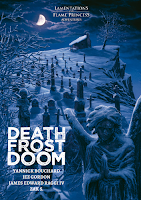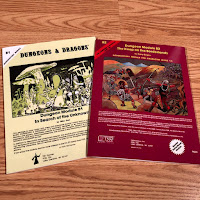I saw Erik Tenkar from Tenkar's Tavern post a pic of Goodman Games new book, Into the Borderlands (check it out), from Gary Con the other day. I heard a couple of months ago about this coming out and it made me really happy, but not out of any sense of nostalgia. I never actually owned a copy of B1 back in the day and the only version of B2 I currently have is the one in the 25th Anniversary TSR box (my original is long gone). I recently picked up the print-on-demand scanned versions of both modules from DriveThruRPG (pictured left) as a way to have disposable play copies. They're a little blurry, but they're serviceable.
Into the Borderlands is a compilation of both the original modules along with 5e updates of the adventures. Even though I don't play 5e D&D, I still may get this just for the new format and to have nice, clear copies of each (hopefully the Otus Minotaur is in there). My happiness about this release is really not about me owning a copy though. I'm happy that newer DMs will get to experience these modules because they fill a gap that I've noticed in modern editions. B1 In Search of the Unknown and B2 The Keep on the Borderlands are two of the best training adventures for both players and DMs ever made, and they prepare gamers to create their own worlds in a way that perhaps modern RPG products don't.
Although I've played in very few modern D&D games, I've noticed a lot of current DMs rely on published adventures and campaign content for their games, much more than I remember doing in the 80s. Sure, everyone liked having the rite of passage of playing through classic adventures like Isle of Dread, Tomb of Horrors, and of course, B1 and B2; but the adventures I remember playing as kids were mostly of our own design. Coming back to gaming in the past year, I don't hear as much talk about people creating their own campaign worlds, at least outside of the OSR community. I see videos about how to run Curse of Strahd or Tomb of Annihilation, but not so much about how to come up with your own stuff. The OSR, by comparison, is all about sharing random tables, one-page dungeon advice, and sandbox toolkits. Meanwhile, the mainstream D&D community seem to view home-brewing as an eccentric option for fringe DMs who choose to miss out on the brilliance of the Forgotten Realms (not that there's anything wrong with FR).
It's possible that this is just my warped perception and foggy memory. However, I see a lot of new DMs asking questions on Facebook, G+, and other forums that I learned the answer to by playing Borderlands. Looking through my new POD copies of B1 and B2, I've started to understand their genius through a new lens of experience and perspective. These two early modules intentionally left a lot of space for the DM to fill in. B1 is completely un-keyed in terms of monsters and treasure. The DM is given lists to choose from and some advice to not use everything and leave some rooms empty. The inhabitants of The Keep in B2 are unnamed beyond their profession, leaving it up to the DM to provide their motives and backstory. B2 also doesn't direct you very much on how to get the players to the Caves of Chaos or give you some overarching plot to move the action. It keys the locations, but you need to make sense of it.
By modern players' and DMs' standards these two modules might seem incomplete, possibly not even suitable for publication compared to newer tomes filled with lore and legend in every hex. B1 and B2 don't do all the work for you. DMs have to do some heavy lifting and players need to ask questions and be curious. These modules don't lead anyone around by the nose to high adventure.
I'm curious to see how this new release plays to modern, 5e D&D gamers. My hopes are two-fold. First, I'd love for this book to teach newer generations of gamers how to think for themselves and come up with their own content, and how to be confident enough in their own ideas to fill in the details on-the-fly. Second, I'd love to introduce or re-acquaint the 5e crowd to the old school way of doing things, where you don't have to rely on official product to tell you how to D&D. We all love fancy new books, but in the end our own imaginations are the best engines of fantasy. I realize it's absurd to expect a complete sea change to happen, but a little bit of old school wisdom wouldn't hurt at all. It would also help to bridge the gap between editions a bit, and that's always a good thing.
One final note: While perusing the Monster stats at the back of B1, I noticed dual Descending/Ascending AC numbers. As the pic to the right shows, the explanation of AC gives the descending AC rank, followed by the to-hit number. Did Mike Carr invent ascending AC in 1979?
Subscribe to:
Post Comments (Atom)
GM Notes - Morgansfort Session 14 - Death Frost Doom - Part 2 of 2
So, here stands the final chronicle of my two-year Basic Fantasy campaign. It ended a year ago and I'm just now getting around to fini...

-
Jeff Easley's BECMI Thief I’ve recently decided to run an OD&D game. This, of course, brings with it the age-old question of whi...
-
It is around 11:30 p.m. Father Thelbain acts quickly and has his acolytes clean up the remains of the dead, mute cultist, Brother Malach...
-
So, here stands the final chronicle of my two-year Basic Fantasy campaign. It ended a year ago and I'm just now getting around to fini...





No comments:
Post a Comment